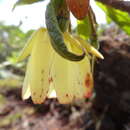zh-TW
在導航的名稱


Dubouzetia is a genus of about eleven species known to science, growing from shrubs up to large trees, in Papuasia and Australasia and constituting part of the plant family Elaeocarpaceae.[2][3][4][5][6][7]
They grow naturally in New Caledonia, New Guinea, the Moluccas,[7] and in Australia in the Northern Territory and north-eastern Queensland.[4]
Some species grow from understorey trees up to large trees in the natural habitats of rainforests, some species grow up to smaller shrubs in drier forests and in Australia two rare species occur, only known from sandstone rocky outcrops.[2][3][7][8]
In Australia, the very restricted north-eastern Queensland endemic species D. saxatilis has official recognition of its risk of extinction in the wild by the Queensland state government's official "vulnerable" species conservation status.[9]: 49
In 1861 European science formally named and described this genus and its New Caledonia type species D. campanulata, authored by the French botanists Adolphe-Théodore Brongniart & Jean Antoine Arthur Gris.[1]
Many species' formal names and descriptions were published since that time, together with a few revisions of the genus or parts of it.[2][3][7][8][10][11][12][13][14][15][16]
Dubouzetia is a genus of about eleven species known to science, growing from shrubs up to large trees, in Papuasia and Australasia and constituting part of the plant family Elaeocarpaceae.
They grow naturally in New Caledonia, New Guinea, the Moluccas, and in Australia in the Northern Territory and north-eastern Queensland.
Some species grow from understorey trees up to large trees in the natural habitats of rainforests, some species grow up to smaller shrubs in drier forests and in Australia two rare species occur, only known from sandstone rocky outcrops.
In Australia, the very restricted north-eastern Queensland endemic species D. saxatilis has official recognition of its risk of extinction in the wild by the Queensland state government's official "vulnerable" species conservation status.: 49